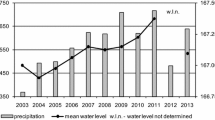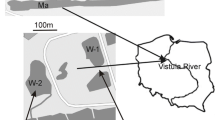Abstract
Thermokarst ponds are the most abundant type of water body in the arctic tundra, with millions occurring in the coastal plains of Alaska, Northwest Territories and Siberia. Because ice covers of at least 2 m in thickness are formed at these latitudes, tundra ponds freeze solid every winter As a result, the growing season is shortened to a range of 60 to 100 days, during which time the photoperiod is altered to a prolonged light phase. Tundra ponds are generally close to neutral in pH and low in ions, contain dissolved gases near saturation and are nutrient poor. In low arctic ponds there are two phytoplankton biomass and primary production peaks, whereas they may be only one in the high arctic. Nanoplanktonic flagellates of the Chrysophyceae and Cryptophyceae dominate the maxima. The mid-summer decline in phytoplankton in the low arctic can be attributed to a combination of phosphorus limitation and heavy grazing pressure. The cryptomonad Rhodomonas minuta Skuja is one of the most widespread phytoplankters in tundra ponds. Because of the altered photoperiods, many species do not form resting spores prior to ice formation but survive freezing in the vegetative state.
Similar content being viewed by others
References
Alexander, V., D. W. Stanley, R. J. Daley & C. P. McRoy, 1980. Primary producers. In J. E. Hobbie (ed.), Limnology of tundra ponds, Barrow, Alaska. U.S./I.B.P. Synth. Ser. 13. Dowden, Hutchinson & Ross. Stroudsburg, Penn.: 179–250.
Britton, M. E., 1957. Vegetation of the arctic tundra. In H. P. Hansen (ed.), Arctic biology. Oregon State Press, Corvallis, Oregon: 26–61.
Brown, J., P. C. Miller L. L. Tieszen & F. L. Bunnell (eds), 1980. An arctic ecosystem. The coastal tundra at Barrow, Alaska. U.S./I.B.P. Synth. Ser. 12. Dowden, Hutchinson & Ross, Stroudsburg, Penn.: 571 pp.
Carson, C. E. & K. M. Hussey, 1960. Hydrodynamics of three arctic lakes. J. Geol. 68: 585–600.
Dodson, S. I., 1979. Body size patterns in arctic and temperate zooplankton. Limnol. Oceanogr. 24: 940–949.
Douglas, L. A. & A. Bilgin, 1975. Nutrient regimes of soils, landscapes, lakes, and streams, Prudhoe Bay, Alaska. In J. Brown (ed.), Ecological Investigations of the Tundra Biome in the Prudhoe Bay region, Alaska. Univ. Alaska spec. Rep. 2, Fairbanks: 61–70.
Hobbie, J. E., 1973. Arctic limnology: A review. In M. E. Britton (ed.), Alaska arctic tundra. Arc. Inst. N. Am. tech. Pap. 25: 127–168.
Hobbie, J. E., 1980. Major findings. In J. E. Hobbie (ed.), Limnology of tundra ponds, Barrow, Alaska. U.S./I.B.P. Synth. Ser. 13. Dowden, Hutchinson & Ross, Stroudsburg, Penn.: 1–18.
Holmgren, S., 1968. Phytoplankton production in a lake north of the Arctic Circle, Fil. Lic. Thesis, Univ. Uppsala, 145 pp.
Hutchinson, G. E., 1957. A treatise on limnology. Vol. 1 Geography, physics, and chemistry. Wiley-Interscience, N.Y., 1015 pp.
Kalff, J., 1967. Phytoplankton abundance and primary production rates in two arctic ponds. Ecology 48: 558–565.
Kalff, J., 1969. A diel periodicity in the optimum light intensity for maximum photosynthesis in natural phytoplankton populations. J. Fish. Res. Bd Can. 26: 463–468.
Kalff, J., 1971. Nutrient limiting factors in an arctic tundra pond. Ecology 52: 655–659.
Legett, R. F., H. B. Dickens & R. J. E. Brown, 1961. Permafrost investigations in Canada. In G. O. Raasch (ed.), Geology in the arctic. University of Toronto Press, Toronto, Ont.: 956–969.
Levitt, J., 1980. Response of plants to environmental stresses. Vol. 1. Chilling, freezing, and high temperature stresses. Academic Press, N.Y., 497 pp.
Livingstone, D. A., 1963. Alaska, Yukon, Northwest Territories, and Greenland. In D. G. Frey (ed.), Limnology in North America. University of Wisconsin Press, Madison: 559–574.
Lowe, C. W., 1923. Report of the Canadian arctic expedition 1913–1918, 4. Botany, A. Freshwater algae and freshwater diatoms. King's Printer, Ottawa, Ontario, 53 pp.
MacKay, J. R., 1963. The Mackenzie Delta area, N. W. T. Geographical Branch Memoir 8, Ottawa, 202 pp.
McCoy, G. A., 1983. Nutrient limitation in two arctic lakes, Alaska. Can. J. Fish. aquat. Sci. 40: 1195–1202.
Miller, M. C., R. T. Prentki & R. J. Barsdate, 1980. Physics. In J. E. Hobbie (ed.). Limnology of tundra ponds, Barrow, Alaska. U.S./I.B.P. Synth. Ser. 13. Dowden, Hutchinson & Ross, Stroudsburg, Penn.: 51–75.
Moore, J. W., 1974. Benthic algae of Southern Baffin Island. II. The epipelic communities in temporary ponds. J. Ecol. 62: 809–819.
Moore, J. W., 1978. Distribution and abundance of phytoplankton in 153 lakes, rivers, and pools in the Northwest Territories. Can. J. Bot. 56: 1765–1773.
Moore, J. W., 1981. Patterns of distribution of phytoplankton in Northern Canada. Nova Hedwigia 34: 599–621.
Ohmura, A., 1982. Evaporation from the surface of the arctic tundra on Axel Heiburg Island. Wat. Resour. Res. 18: 291–300.
Prentki, R. T., M. C. Miller, R. J. Barsdate, V. Alexander, J. Kelley & P. Coyne, 1980. Chemistry. In J. E. Hobbe (ed.), Limnology on tundra ponds, Barrow, Alaska. U.S./I.B.P. Synth. Ser. 13. Dowden, Hutchinson & Ross, Stroudsburg Penn.: 76–178.
Prescott, G. W., 1963. Ecology of Alaskan freshwater algae, 2. Introduction: general considerations. Trans. am. microsc. Soc. 82: 83–142.
Pruitt, W. O., Jr., 1978. Boreal ecology. Studies in Biology 91. Arnold, Lond., 73 pp.
Rawson, D. S., 1953. Limnology in the North American arctic and subarctic. Arctic 6: 198–204.
Rodin, L. E., N. I. Bazilevich & N.N. Rozov, 1975. Productivity of the world's main ecosystems. In: Productivity of world ecosystems. Proc. Symp., Aug. 31-Sept. 1, 1972, Seattle, Wash. Natn. Acad. Sci., Wash.: 13–26.
Sheath, R. G., M. Munawar & J. A. Hellebust, 1975. Phytoplankton biomass composition and primary productivity during the ice-free period in a tundra pond. In Proc. Circumpolar Conf. arct. Ecol., Natn. Res. Counc., Ottawa, 3: 21–31.
Sheath, R. G. & J. A. Hellebust, 1978. Comparison of algae in the euplankton, tychoplankton, and periphyton of a tundra pond. Can. J. Bot. 56: 1472–1483.
Sheath, R. G., M. Havas, J. A. Hellebust & T. C. Hutchinson, 1982. Effects of long-term natural acidification on the algal communities of tundra ponds at the Smoking Hills, N. W. T., Canada. Can. J. Bot. 60: 58–72.
Sheath, R. G. & A. D. Steinman, 1982. A checklist of freshwater algae of the Northwest Territories, Canada. Can. J. Bot. 60: 1964–1997.
Stanley, D. W., 1976. Productivity of epipelic algae in tundra ponds and a lake near Barrow, Alaska. Ecology 57: 1015–1024.
Stanley, D. W. & R. J. Daley, 1976. Environmental control of primary productivity in Alaskan tundra ponds. Ecology 57: 1024–1033.
Steponkus, P. L., 1984. Role of the plasma membrane in freezing injury and cold acclimation. Ann. Rev. Pl. Physiol. 35: 543–584.
Stross, R. G., M. C. Miller & R. J. Daley, 1980. Zooplankton. In J. E. Hobbie (ed.), Limnology of tundra ponds, Barrow, Alaska. U.S./I.B.P. Synth. Ser. 13. Dowden, Hutchinson & Ross, Stroudsburg, Penn.: 251–296.
Yamagishi, T., 1967. Some filamentous Chlorophyceae in the Alaskan arctic. Bull. Natn. Sci. Mus., Tokyo 10: 201–206.
Yamagishi, T., 1969. Unicellular and colonial Chlorophyceae in the Alaskan arctic. Gen. Educ. Rev. Coll. Agr. Vet. Med., Nihon Univ. 5: 18–29.
Yamagishi, T., 1970. A check-list of the Euglenophyceae and Chrysophyceae in the Alaskan arctic. Gen. Educ. Rev. Coll. Agr. Vet. Med., Nihon Univ. 6: 11–22.
Yancey, P. H., M. E. Clark, S. C. Hand, R. D. Bowlus & G. N. Somero, 1982. Living with water stress: Evolution of osmolyte systems. Science 217: 1214–2222.
Wetzel, R. G., 1983. Limnology, 2nd Edn. Saunders College Publishing, Philadelphia, Penn., 753 pp.
Author information
Authors and Affiliations
Rights and permissions
About this article
Cite this article
Sheath, R.G. Seasonality of phytoplankton in northern tundra ponds. Hydrobiologia 138, 75–83 (1986). https://doi.org/10.1007/BF00027233
Issue Date:
DOI: https://doi.org/10.1007/BF00027233




